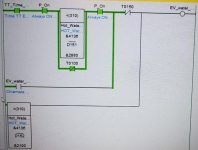James Mcquade
Member
Hi all,
i have a hot water tank (500 gallon best guess) that uses a valve controlled by the plc to fill it.
there is an analog 4-20 ma sensor that monitors the water level. it is connected to an MAD42 card.
every week or two, we have to drain the tank of water so we can clean it.
i have logic that works as long as the tank is at least 30% full - best guess.
the issue is that when you first turn the tank on, the analog sensor acts strange and stops the valve from turning on.
there is 2 conditions. when the hot water level is less than &2100 turn the valve on , then when it reaches &2100, fill the tank based on a timer until full.
What happens is the Hot_Water analog sensor value goes below 0 and the value turns to (-65535) or goes way above & 3000 and stays for a good while before returning back to normal.
is there some type of filter (plc logic) i can use to fix the issue?
please see the attached picture.
Thanks in advance,
james

i have a hot water tank (500 gallon best guess) that uses a valve controlled by the plc to fill it.
there is an analog 4-20 ma sensor that monitors the water level. it is connected to an MAD42 card.
every week or two, we have to drain the tank of water so we can clean it.
i have logic that works as long as the tank is at least 30% full - best guess.
the issue is that when you first turn the tank on, the analog sensor acts strange and stops the valve from turning on.
there is 2 conditions. when the hot water level is less than &2100 turn the valve on , then when it reaches &2100, fill the tank based on a timer until full.
What happens is the Hot_Water analog sensor value goes below 0 and the value turns to (-65535) or goes way above & 3000 and stays for a good while before returning back to normal.
is there some type of filter (plc logic) i can use to fix the issue?
please see the attached picture.
Thanks in advance,
james




